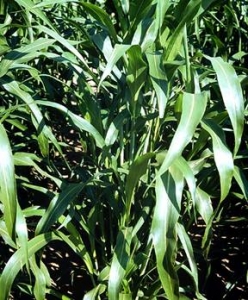Forage and Silage
Canadian forage sorghum, hybrid 30 (Sudan-Multicut)

Sorghum is mainly grown in temperate areas as a part of the regular feeding program for livestock to supplement the short fall in pasture production during summer and fall months or as an emergency crop to provide forage, after winter kill of perennial grasses or after failure of a main crop. It is a cheaper feed than corn with less fertilizer requirement, less pest control and one third less water. Sorghum grows well on all type of soils. The plant can reach over four feet in height and produces several tillers. Forage sorghum is drought and heat tolerant but frost sensitive. The area planted annually under Sudan grass in the US is about 4 million acres. Forage sorghum is grown in Canada with seeds imported from USA. AERC Inc. has developed new multi-cut forage sorghum hybrids adapted to the Canadian climate.
Canadian Forage Sorghum Hybrid 30 is developed from Sudan type parents. It is high yielding fine stemmed, and could produce over two to three cuttings during the growing season. It provides a wide range of uses to the grower. It may be used for hay, haylage, silage, green chop or pasture. This has excellent recovery after harvesting or grazing. Fine leafy stems makes it an excellent choice for hay. The CFSH 30 hybrid developed in Ontario had 1.0 ppm (% DM) of prussic acid levels after the frost, whereas US Sudan grass had 5.3 ppm (% DM). Prussic acid level of less than or equal to 250 ppm (% DM) is safe to pasture.
Characters of CFSH 30:
![]() In-determinate growth
In-determinate growth
![]() Can grow 3 - 6 feet with 3 - 6 Tillers per plant
Can grow 3 - 6 feet with 3 - 6 Tillers per plant
![]() 6 - 10 leaves per plant per cut with high leaf stem ratio;
6 - 10 leaves per plant per cut with high leaf stem ratio;
![]() Flowering in 45-60 days with 2-3 cuttings per cropping season;
Flowering in 45-60 days with 2-3 cuttings per cropping season;
![]() Frost sensitive with safe level of prussic acid;
Frost sensitive with safe level of prussic acid;
![]() Seed size is small with 1000 seed weight of 14 – 16 gm.
Seed size is small with 1000 seed weight of 14 – 16 gm.
Forage yield and quality:
|
Parameter |
CFSH 30* |
US Sudan* |
Corn** |
|
Forage Dry Matter Yield (ton/acre) |
2.7-4.4 |
2.7-4.1 |
4-6 |
|
Crude Protein (%dm) |
14-16 |
14-15 |
8-9 |
|
Acid Detergent Fiber(%dm) |
29-31 |
28-32 |
25-35 |
|
Neutral Detergent Fiber(%dm) |
56-58 |
56-60 |
50-55 |
|
Posphorous(%dm) |
0.3-0.4 |
0.3-0.4 |
0.22 |
|
Calcium(%dm) |
0.4-0.6 |
0.5-0.6 |
0.23 |
|
Total Digestiable Nutrients(%dm) |
66-67 |
65-67 |
60-70 |
Animal Feeding trials:
Forage Sorghum feeding trials with dairy and beef cattle have been conducted at Kemptville College, University of Guelph since 1998.The nutrient profile of CFSH 30 silage at Kemptville College were 16.2 % crude protein (CP), 34.5 % acid detergent fiber (ADF) 57.5 % neutral detergent fiber (NDF) and 61.3 % total digestible nutrients (TDN) respectively whereas the typical corn silage values are 7.4 % CP, 24.9 % ADF, 42.8% NDF, and 65.8 % TDN. Research also showed that dry matter yield for Canadian developed forage sorghum hybrid 30 (9.5 t/ha) were comparable to corn silage (10 t/ha).
Milk production in late lactation dairy cows:
|
Parameter |
Sorghum silage |
Corn silage |
|
Dry matter intake (kg/day) |
23.1 a |
22.2 a |
|
Milk production (kg/day) |
34.1 a |
32.4 a |
|
Milk fat (%) |
3.70 a |
3.66 a |
|
Milk protein (%) |
3.70 a |
3.53 a |
Dairy cows with AERC’s sorghum silage had similar dry matter intake, milk yield and milk composition as compared to the control diet with alfalfa-corn silage.
Beef Cattle Feeding Trial Dairy Cattle Feeding Trial


Body Weight gain in beef heifer
|
Type of diet |
Initial body weight (kg/animal) |
Final body weight (kg/animal) |
|
AERC’s sorghum silage |
325.9 a |
421.3 b |
|
Mixed haylage |
315.6 a |
414.6 b |
Beef heifers produced a weight gain of 0.88 kg/day with AERC’s sorghum silage, whereas the mixed haylage and alfalfa grass gained only 0.82 kg/day.
Research on Adaptability, Agronomy and Utilization of AERC’s Forage Sorghum Hybrids are being conducted across Canada in Partnership with Agriculture and Agri Food Canada, Ontario Ministry of Agriculture Food and Rural Affairs, University of Guelph, Quebec Ministry of Agriculture and Rural Affairs and several other Government and Private Research Organizations.























